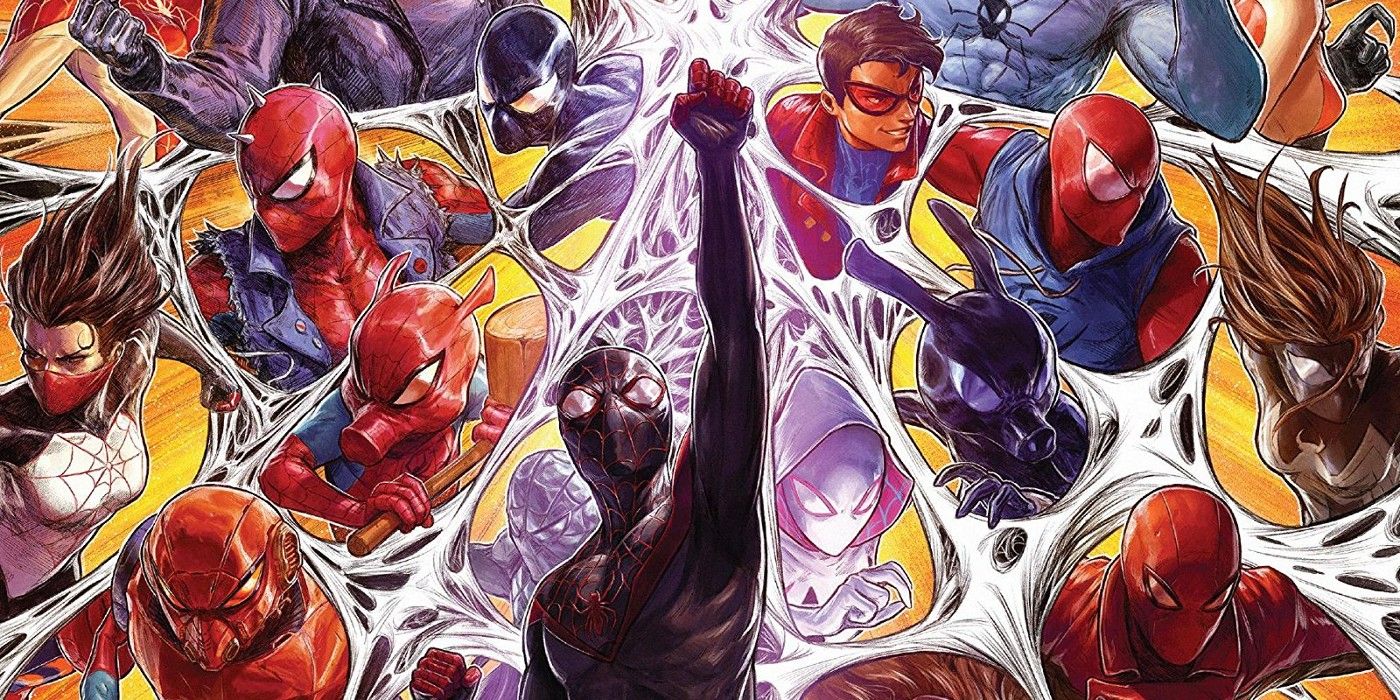Contains spoilers for Edge of the Spider-Verse #2
Marvel Comics has finally disclosed the origins of Spider-Man's own multiverse, the Spider-Verse. Despite being hugely popular and spawning successful comic book series and the hit movie Into the Spider-Verse, the details about the Spider-Verse's origins and creators have remained mostly shrouded in mystery, until now.
Dan Slott pitched the idea for a Spider-Verse crossover to Marvel after working on the story of Activision's game Shattered Dimension, which featured four Spider-Men from different realities working together. However, the concept behind the series would not exist without J. M Straczynski's run on Amazing Spider-Man, which introduced the idea of Spider-Totems as the mystical source of every spider-based hero, and also Morlun and the Inheritors, the big multiversal villains featured in the 2014's Spider-Verse crossover. The success of the series greatly expanded Spider-Man's lore, introducing new characters (such as the popular Spider-Gwen) and a new purpose for the spider-heroes, connecting them to the multiversal construct called the Web of Life and Destiny, which gives them their powers. However, neither Spider-Verse nor its sequel Spider-Geddon explained exactly what the Web of Life and Destiny is, and its supposed creator, the spider deity called the Great Weaver, remained mostly a mystery.
In "A Single Thread," a story by Dan Slott, Paco Medina, and Brian Reber, contained in Edge of the Spider-Verse #2, Marvel unexpectedly reveals the origins of the Web, and thus of the Spider-Verse. The Web was actually created by Neith, an elder goddess from Earth-001 (the world where the physical construct of the Web lies), the daughter of Gaea and Oshtur and the sister of Shathra, a wasp-like goddess who has already appeared as a Spider-Man villain. Gaea and Oshtur task Shathra with designing the "celestial map of humanity," a cosmic construct that will chart out their entire destiny. However, Shathra's design (a hive) is overshadowed by Neith's proposal, a web that leaves humanity their free will. The Web is placed at the center of the universe and Neith gives her spiders (the ancestors of the Spider-Totems) the task of overseeing the Web and fixing its threads.
It is honestly surprising that Marvel does not give more prominence to this huge lore reveal. Neith is a brand-new character who expands the already extensive pantheon of Marvel gods. Her role as the elder spider goddess opens up a lot more questions, such as why she never appeared on Earth-616 or why she never spoke directly to her totems like her fellow gods do (one panel shows her in the company of Khonshu and Bast, who have a much closer relationship with their chosen representatives, Moon Knight and Black Panther). More importantly, however, the story finally explains the purpose and origins of the so-called Spider-Verse. The Web serves as a map that charts humanity's destiny and the Spider Totems have the ability to travel from one strand (or universe) to another because of their cosmic duty of maintaining the integrity of the Web.
These revelations also give Spider-Man and all his related heroes a much more important role in the Marvel multiverse. They are the shepherds of destiny and the protectors of humankind on a cosmic level. As the Spider-Man of Earth-616 (theoretically the most important one in the multiverse), Peter Parker is at the center of all this, at least until Marvel brings this huge multiversal plot to its end in the announced The End of the Spider-Verse series, coming at the end of 2022.

